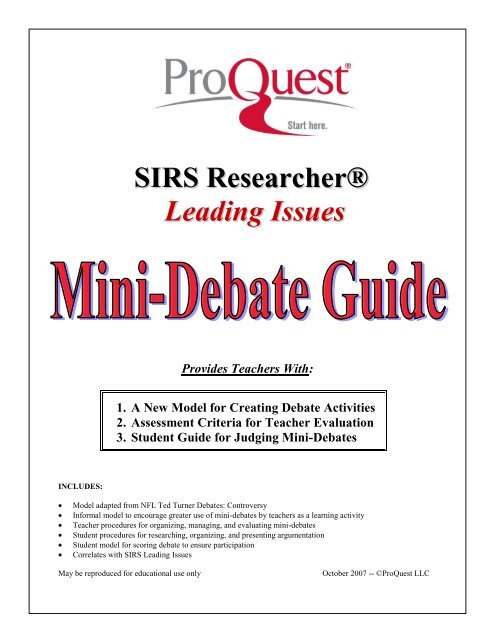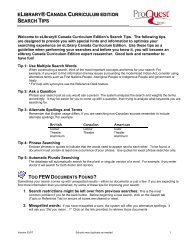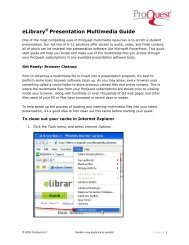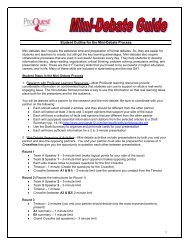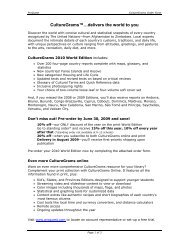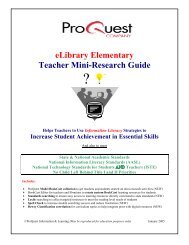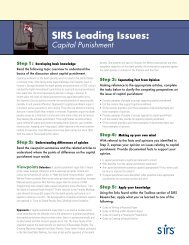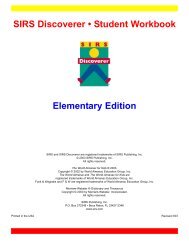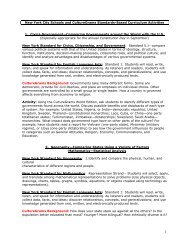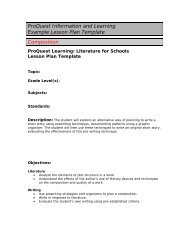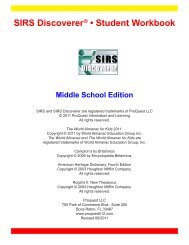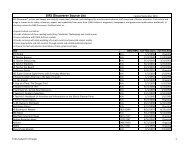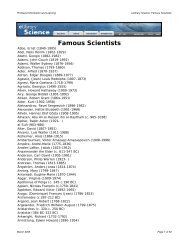Mini-Debate Format - ProQuest
Mini-Debate Format - ProQuest
Mini-Debate Format - ProQuest
Create successful ePaper yourself
Turn your PDF publications into a flip-book with our unique Google optimized e-Paper software.
SIRS Researcher®<br />
Leading Issues<br />
Provides Teachers With:<br />
1. A New Model for Creating <strong>Debate</strong> Activities<br />
2. Assessment Criteria for Teacher Evaluation<br />
3. Student Guide for Judging <strong>Mini</strong>-<strong>Debate</strong>s<br />
INCLUDES:<br />
Model adapted from NFL Ted Turner <strong>Debate</strong>s: Controversy<br />
Informal model to encourage greater use of mini-debates by teachers as a learning activity<br />
Teacher procedures for organizing, managing, and evaluating mini-debates<br />
Student procedures for researching, organizing, and presenting argumentation<br />
Student model for scoring debate to ensure participation<br />
Correlates with SIRS Leading Issues<br />
May be reproduced for educational use only<br />
October 2007 -- ©<strong>ProQuest</strong> LLC
Teacher’s Guide to the <strong>Mini</strong>-<strong>Debate</strong> <strong>Format</strong> for SIRS Leading Issues<br />
The following rules and procedures were developed by SIRS to motivate teachers to integrate more<br />
debate activities in their classrooms, using SIRS Leading Issues. The rules and procedures are adapted<br />
from the National Forensic Leagues new Ted Turner <strong>Debate</strong> <strong>Format</strong> which is named CONTROVERSY:<br />
http://debate.uvm.edu/NFL/rostrumlib/ted%20intro%20roberts%2011-02.pdf<br />
Why <strong>Mini</strong>-<strong>Debate</strong>s?—There are millions of high school students who have never debated and will never<br />
debate because current formal debate rules and procedures require a major commitment of time and<br />
expertise by teachers, students, and judges. The inherent value of the research, critical thinking and<br />
presentation skills found in debate activities are then lost as a learning opportunity for all these<br />
students. By simplifying the rules and judging, and decreasing the time needed for the activity, teachers<br />
will be motivated to create these engaging “mini-debates” which provide the excitement and develop the<br />
essential skills that students will use in higher education, careers, and decision making in life and<br />
citizenship.<br />
Another goal is to encourage schools to include debate as a co-curricular activity in schools that<br />
currently do not debate and maybe never have. <strong>ProQuest</strong> understands that the cost and complexity of<br />
formal debate teams and leagues has made debate impossible for small schools and for schools without<br />
extensive financial resources.<br />
A third goal is to include debate activities in schools that use block scheduling. Block scheduling provides<br />
greater opportunities for debate because of its longer class periods.<br />
SIRS Leading Issues uses current controversial subjects that have strong ties to curriculum, state<br />
standards, and student interests. Research for mini-debates can be accomplished primarily by using the<br />
SIRS Leading Issues template. This template includes time-saving tools for students and teachers<br />
without compromising the learning process and the development of critical reading, analysis, synthesis,<br />
organization, writing, and presentation skills. Each issue includes the following time saving startups:<br />
1. An introduction to why the issue is important and what it is about<br />
2. A brief summary of the arguments that currently support the issue<br />
3. A brief summary of the arguments that currently oppose the issue<br />
4. A list of critical thinking questions that guide student focus in the research process<br />
5. An emphasis on separating facts from opinion on the issue and in the readings<br />
6. Links to a variety of guides, including the following: Guide to Writing a Research Paper, Guide to<br />
Writing a <strong>Mini</strong>-Research Paper, Guide to Creating a PowerPoint Presentation, and Guide to<br />
Creating a <strong>Debate</strong> Outline<br />
Correlation to State and National Standards<br />
The following statements are typical of those found in state standards particularly those in English<br />
Language Arts. Student will be able to:<br />
1. Conduct research using multiple sources to support a position in a debate<br />
2. Put information from multiple sources into debate format<br />
3. Participate in a debate arguing one position in an effective and focused manner<br />
4. Connect information and events in text to experience and to related text and sources<br />
5. Locate specific information by using organizational features in expository text<br />
6. Synthesize information from multiple sources to draw conclusions<br />
7. Deliver a polished speech that is organized and suited to the audience and that uses resource<br />
materials to clarify and defend positions<br />
8. Evaluate the effectiveness of informal and formal presentations that use illustrations, statistics,<br />
comparisons, and analogies<br />
1
The <strong>ProQuest</strong> <strong>Mini</strong>-<strong>Debate</strong> <strong>Format</strong><br />
1. Two speakers for each side of the issue<br />
2. Teacher determines which students are pro and con on the stated issue<br />
3. Each speaker is to use note cards synthesized from Leading Issues research<br />
4. Teams may flip a coin to determine sides and speaker order<br />
5. Speakers should take notes during opposing speaker presentations for Crossfire questions<br />
<strong>Mini</strong>-<strong>Debate</strong> Activities Sequence and Time Limits<br />
Team A Speaker 1 -- 3 minute limit<br />
Team B Speaker 1 -- 3 minute limit<br />
Timeout – 1 minute<br />
Crossfire (between A1 & B1) 2 minute limit<br />
Team A Speaker 2 -- 3 minute limit<br />
Team B Speaker 2 -- 3 minute limit<br />
Timeout – 1 minute<br />
Crossfire (between A2 & B2) 2 minute limit<br />
Timeout – 2 minutes<br />
A1 summary -- 1 minute limit<br />
B1 summary -- 1 minute limit<br />
Grand Crossfire (all speakers) -- 3 minute limit<br />
Timeout – 2 minutes<br />
A2 Last Shot -- 1 minute limit<br />
B2 Last Shot -- 1 minute limit<br />
Total Time Including Timeouts = 29 minutes<br />
Research Instructions—Each speaker for a side will coordinate with and develop at least 3 facts and 3<br />
expert opinions that are different than their partner for their initial presentations. Each will use the editor<br />
selected resources of SIRS Leading Issues for the side of the issue that they will present. At the end of<br />
case researching and writing, each speaker’s cases should be checked to be sure they reflect the<br />
following elements:<br />
1. Each speaker for each side of the issue opens with a different set of 3 arguments<br />
2. They fit the 3-minute time limit<br />
3. They include at least 3 of the following examples: real world, philosophical, historical, and<br />
economic<br />
4. Numbers, facts, and expert opinions are incorporated<br />
Speaker Instructions—Each speaker will outline the presentation so that it fits into the 3-minute time<br />
limit. Each will use separate note cards or papers for each point that you make including examples. When<br />
the opposing team speaks, each will take notes for the Crossfires.<br />
Crossfire Instructions—During the Crossfire period, both speakers have the floor and may ask and<br />
answer questions during the 2-minute period. The participants are instructed to keep questions and<br />
answers succinct; rudeness should not be tolerated. In the Grand Crossfire all four students have the<br />
floor. The first question must be posed by the team which did not speak just prior to the Crossfire period.<br />
One partner can take the role of questioner while the other mollifies the opposition.<br />
A stronger partner can cover for a weaker partner.<br />
2
Partners can mutually intervene to deflect questions from their opponents in order to try<br />
to unsettle well-placed attacks.<br />
Partners can interrupt each other, not just the opposition, to shift the focus of questions<br />
and attacks.<br />
Summary Speaker Instructions—Summary speakers will take notes of the most compelling reasons<br />
presented by themselves and their partner that are most likely to counter the arguments of their<br />
opponents and will rebuild audience connections by refocusing upon the central issue.<br />
Last Shot Instructions—Last Shot speakers choose the one issue which matters the most and use the<br />
importance of this issue to frame the final parting shot.<br />
Judging the <strong>Debate</strong>—Students in the class should be used and be active in judging the debate to<br />
determine a winning side based on a rubrics scoring system. The teacher should make copies of the<br />
rubrics system for students to use and then the teacher should serve as the timekeeper. When some<br />
experience is gained, parents can be invited to participate as judges, using the same rubrics scoring<br />
system.<br />
Teacher Rubrics for Evaluating a <strong>Mini</strong>-<strong>Debate</strong><br />
The following are examples of evaluative criteria that the teacher can use to build a rubrics evaluation<br />
model for the mini-debate:<br />
Preparation: Preparation includes the research process and the organization of materials to make the<br />
presentation.<br />
1. Did the team use the student guide to help organize their research?<br />
2. Did the team coordinate their presentations to minimize redundancy?<br />
3. Did the team prepare appropriate and organized materials to make their presentation?<br />
Evidence: Evidence refers not only to statistics, facts and references to authority, but also to items of<br />
common or general knowledge.<br />
1. Did the team show connections between particular events or issues and large social, economic,<br />
and/or political concerns, trends or developments?<br />
2. Did the team supply appropriate and sufficient evidence to support its arguments, and apply that<br />
evidence clearly and logically?<br />
3. Did the team adequately explain and/or analyze the evidence offered during the debate?<br />
Analysis and Argumentation: Did each team sufficiently address the topic in an organized and<br />
consistent manner?<br />
1. Did the team present logical, reasonable, and convincing arguments?<br />
2. Did the team clearly and effectively discuss, explain and evaluate the issues and arguments<br />
offered during the debate?<br />
3. Did the team respond directly to opposing arguments, interpretations, and/or analyses, with clear<br />
explanations of the weakness of opposing arguments?<br />
4. Did the team apply clear evaluative criteria to the arguments, interpretations, and/or analyses<br />
offered during the debate?<br />
5. Did the team demonstrate an understanding of the social, political, and/or economic issues<br />
involved in the debate?<br />
Crossfire:<br />
1. Did the debater provide relevant, focused and brief questions?<br />
2. Did the debater respond effectively to questions?<br />
3. Did the debater demonstrate respect for opponents by cooperating in a polite "give and take"<br />
without dominating the discussion?<br />
3
Presentation:<br />
1. Did the debater communicate in a clear, organized, and understandable manner, presenting an<br />
easy listening path to follow?<br />
2. Did the debater exemplify the highest standards of language usage, style and vocabulary,<br />
avoiding slang, poor grammar, and mispronunciations?<br />
3. Did the speaker use effective body language (poised stage presence, appropriate gestures, facial<br />
expression, and eye contact)?<br />
4. Did the speaker use effective oral presentation skills (volume, diction, rate of delivery), and use<br />
understandable and persuasive delivery)?<br />
5. Was the debater respectful and courteous to opponents?<br />
Student Tips for Success in the <strong>Mini</strong>-<strong>Debate</strong><br />
1. Each partner should select at least 3 articles from SIRS Leading Issues that support their<br />
side of the mini-debate.<br />
2. Copy/paste facts, opinions, and examples from each article you read into a blank Draft<br />
Summary document that will be used to organize your information. An alternative is to<br />
print and highlight the information but then this info must be transferred to note cards or<br />
paper creating more work later.<br />
3. Organize your presentation onto separate sheets of paper by copying and pasting the<br />
best information from the Draft Summary document.<br />
4. Organize enough information for your opening statement (3 minutes) and coordinate with<br />
your partner to make sure you are not both presenting the same information.<br />
5. Create at least 5 questions that you can ask your opponents during the Crossfires. These<br />
should be on sheets of papers or note cards for easy reference.<br />
6. Anticipate that your opponents will ask at least 5 questions in the Crossfires. Prepare<br />
answers to them on sheets of paper or note cards. What questions would you ask if you<br />
were on the opposing team?<br />
7. Prepare a powerful final conclusive argument/statement which will be written at the end of your<br />
debate. This should be no longer than 1 minute. Take notes during the debate so that you tailor<br />
this statement to your team’s strengths and your opponents’ weaknesses.<br />
Student Rubrics Model to Participate and Determine the <strong>Debate</strong> Winner<br />
<strong>Debate</strong> Activities Sequence Affirmative Score Negative Score<br />
Scoring--Convincing = 4; Satisfactory = 2; Little Impact = 1<br />
Affirmative (Pro Issue) Speaker 1<br />
Negative (Con Issue) Speaker 1<br />
Crossfire for the Affirmative (Pro Issue)<br />
Crossfire for the Negative (Con Issue)<br />
Affirmative (Pro Issue) Speaker 2<br />
Negative (Con Issue) Speaker 2<br />
Crossfire for the Affirmative (Pro Issue)<br />
Crossfire for the Negative (Con Issue)<br />
Affirmative Speaker 1 (Pro Issue) Summary<br />
Negative Speaker 1 (Con Issue) Summary<br />
Grand Crossfire (all speakers) for the Affirmative (Pro)<br />
Grand Crossfire (all speakers) for the Negative (Con)<br />
Affirmative Speaker 2 (Pro Issue) Last Shot<br />
Negative Speaker 2 (Con Issue) Last Shot<br />
Student Evaluator:<br />
Totals<br />
4


